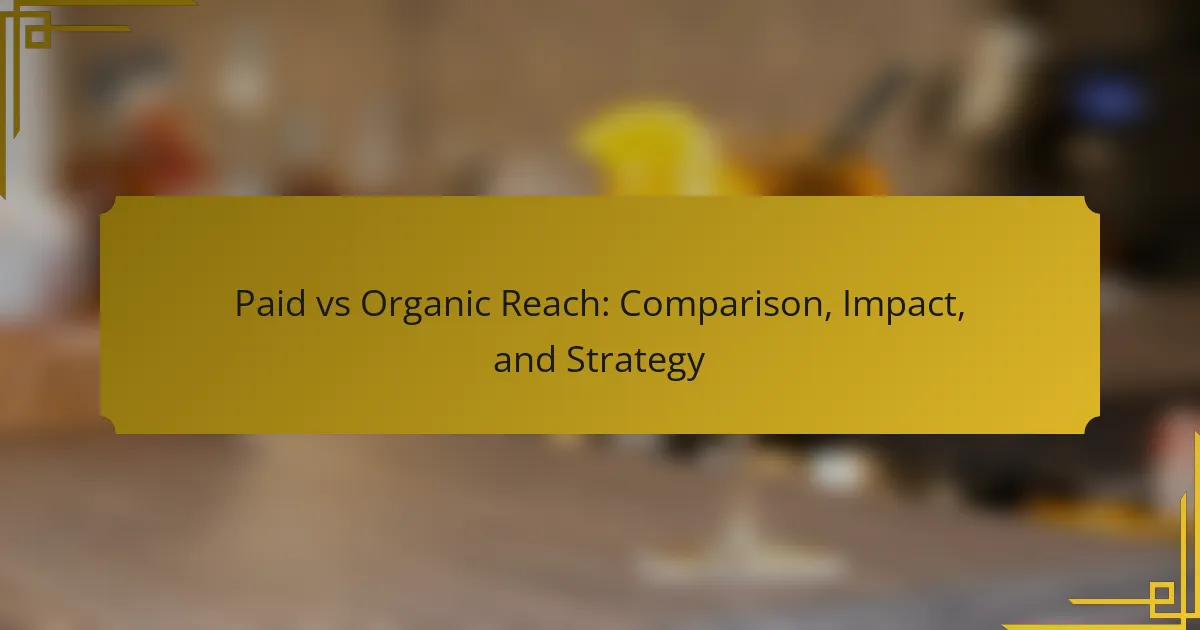In the digital marketing landscape, understanding the differences between paid and organic reach is crucial for effective strategy development. Paid reach leverages advertising to quickly connect with targeted audiences, while organic reach focuses on building lasting relationships through valuable content. By integrating both approaches, businesses can enhance their visibility and engagement, ultimately driving better results.
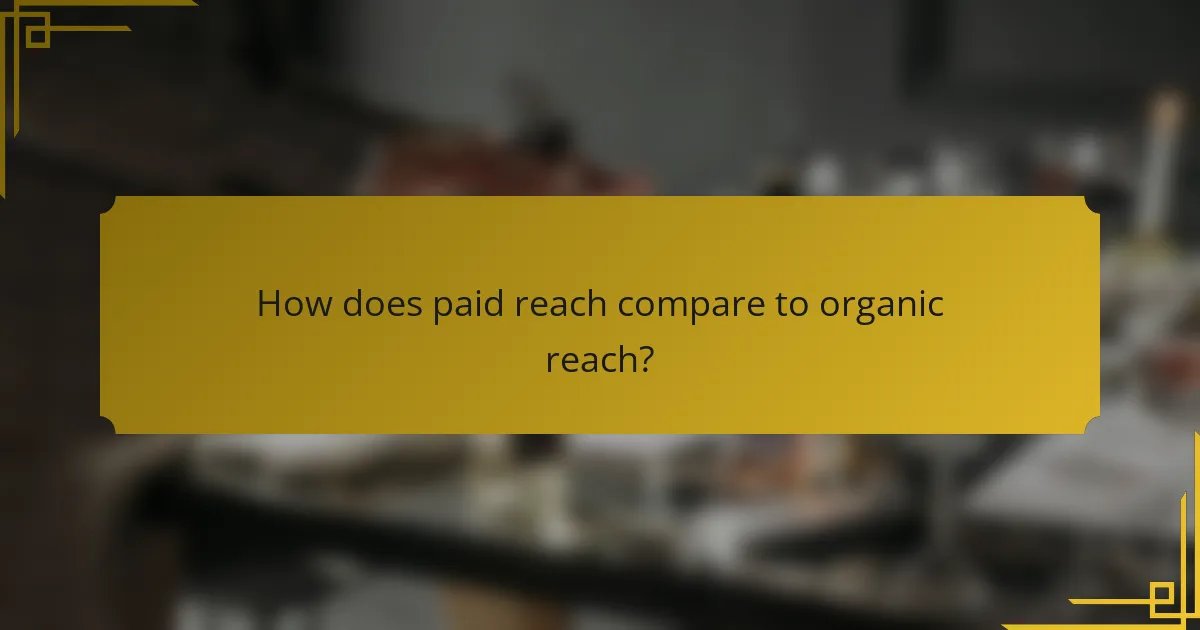
How does paid reach compare to organic reach?
Paid reach involves promoting content through advertising, while organic reach relies on unpaid methods to attract an audience. Both strategies have distinct advantages and can complement each other to enhance overall visibility.
Definition of paid reach
Paid reach refers to the number of people who see your content as a result of paid advertising efforts. This can include social media ads, sponsored posts, and pay-per-click campaigns. The primary goal is to increase visibility quickly and effectively by targeting specific demographics.
Definition of organic reach
Organic reach is the number of unique users who see your content without any paid promotion. This typically occurs through shares, likes, comments, and search engine results. Building organic reach often requires consistent engagement and high-quality content to attract and retain an audience over time.
Key differences between paid and organic reach
The main difference between paid and organic reach lies in their cost and speed. Paid reach can generate immediate visibility but requires ongoing investment, while organic reach builds gradually and is cost-effective in the long run. Additionally, organic reach often results in higher engagement rates as users may trust content that appears naturally in their feeds.
Another key difference is the control over targeting. Paid reach allows for precise targeting based on demographics, interests, and behaviors, whereas organic reach relies on the content’s appeal to attract a broader audience without specific targeting.
Examples of paid and organic reach
Examples of paid reach include Facebook ads, Google Ads, and Instagram sponsored posts, where brands pay to have their content displayed to targeted users. These methods can yield quick results, especially for promotions or product launches.
On the other hand, organic reach can be exemplified by a blog post that gains traction through shares on social media or a video that goes viral due to its engaging content. Successful organic strategies often involve SEO optimization, regular posting, and community engagement to enhance visibility without direct costs.
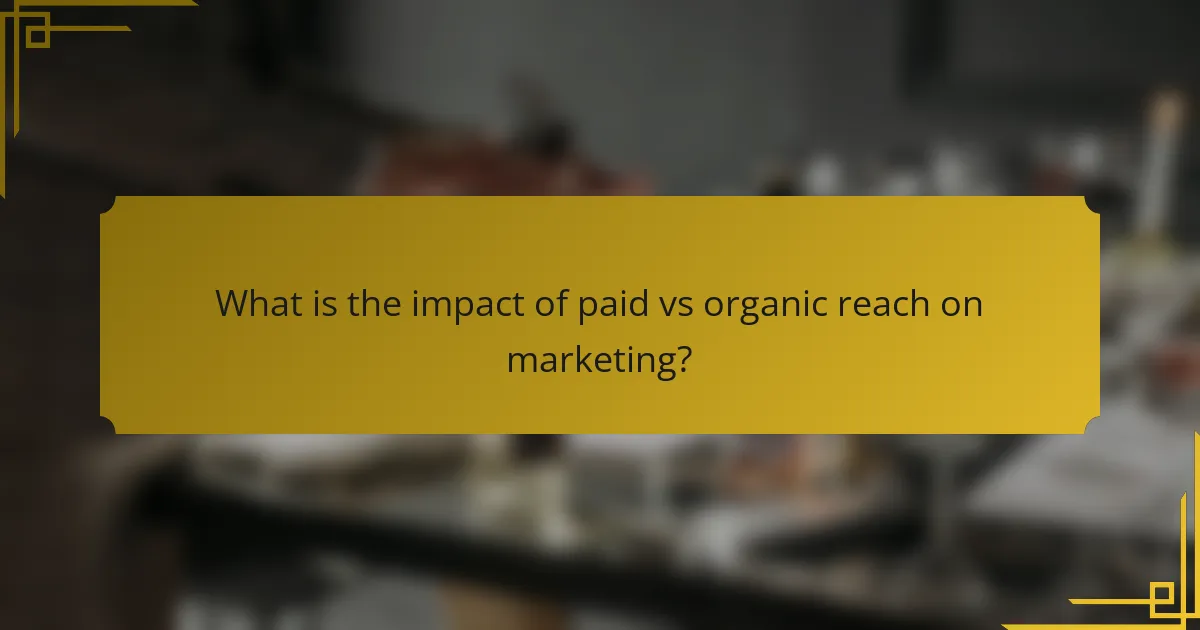
What is the impact of paid vs organic reach on marketing?
The impact of paid versus organic reach on marketing is significant, as each approach influences audience engagement and brand visibility differently. Paid reach provides immediate access to targeted audiences, while organic reach builds long-term relationships and credibility through valuable content.
Benefits of paid reach
Paid reach allows marketers to quickly amplify their message to a specific audience, ensuring that campaigns achieve visibility in a crowded marketplace. This method often results in faster lead generation and immediate traffic spikes, which can be crucial for time-sensitive promotions.
Additionally, paid advertising platforms offer robust targeting options, enabling businesses to reach demographics based on interests, behaviors, and location. This precision can lead to higher conversion rates, making it a valuable strategy for immediate sales goals.
Benefits of organic reach
Organic reach fosters trust and loyalty by engaging audiences through authentic content. This approach encourages users to share content naturally, which can lead to a more extensive and engaged audience over time without the need for continuous investment.
Moreover, organic reach contributes to brand authority and SEO performance. High-quality content that resonates with users can improve search engine rankings, leading to sustained visibility and traffic without ongoing costs associated with paid advertising.
Long-term vs short-term impact
Paid reach typically delivers short-term results, making it ideal for campaigns that require immediate attention, such as product launches or seasonal sales. However, the effects of paid campaigns often diminish once the budget is exhausted.
In contrast, organic reach builds a foundation for long-term success. While it may take time to see significant results, the ongoing benefits include sustained traffic, lower customer acquisition costs, and a loyal audience base. Balancing both strategies can maximize overall marketing effectiveness.

What strategies can enhance paid and organic reach?
Enhancing both paid and organic reach involves a combination of targeted advertising, quality content creation, and strategic integration. By focusing on effective methods for each approach, businesses can maximize their visibility and engagement across various platforms.
Effective paid advertising strategies
To boost paid reach, consider using targeted ads on platforms like Google Ads or Facebook Ads. These platforms allow for precise audience segmentation based on demographics, interests, and behaviors, ensuring that your ads reach the most relevant users.
Utilizing A/B testing can significantly improve ad performance. By experimenting with different headlines, images, and calls to action, you can identify what resonates best with your audience, optimizing your budget for maximum impact.
Setting clear objectives is crucial. Whether your goal is brand awareness or lead generation, aligning your ad strategy with specific outcomes helps in measuring success and adjusting tactics accordingly.
Best practices for organic growth
For organic reach, creating high-quality, relevant content is essential. Focus on producing valuable articles, videos, or infographics that address your audience’s needs and interests, which can lead to increased shares and engagement.
Search Engine Optimization (SEO) plays a vital role in enhancing organic visibility. Incorporate relevant keywords naturally into your content, optimize meta tags, and ensure your website is mobile-friendly to improve search rankings.
Engaging with your audience through social media and community forums can also foster organic growth. Responding to comments, participating in discussions, and sharing user-generated content builds trust and encourages further interaction.
Integrating paid and organic strategies
Combining paid and organic strategies can amplify your overall reach. For instance, using paid ads to promote high-performing organic content can drive immediate traffic while enhancing its visibility and credibility.
Consider retargeting ads for users who have engaged with your organic content. This approach keeps your brand top-of-mind and encourages conversions from those who have already shown interest.
Lastly, analyze the performance of both strategies together. Use analytics tools to track how paid efforts influence organic traffic and vice versa, allowing for data-driven adjustments to your marketing strategy.

What are the criteria for choosing between paid and organic reach?
Choosing between paid and organic reach depends on factors like budget, target audience, and campaign objectives. Each approach has its strengths and weaknesses, making it essential to evaluate these criteria to align your marketing strategy with your goals.
Budget considerations
Budget is a primary factor when deciding between paid and organic reach. Paid advertising typically requires a significant upfront investment, with costs varying widely based on platform, competition, and targeting options. Organic reach, while cost-effective in terms of direct spending, often demands a substantial time investment for content creation and community engagement.
For example, businesses may spend anywhere from a few hundred to several thousand dollars monthly on paid ads, while organic strategies might require ongoing resources for SEO and content marketing without direct ad spend. Assessing your financial capacity will help determine the best approach.
Target audience analysis
Understanding your target audience is crucial in deciding between paid and organic reach. Paid campaigns allow for precise targeting based on demographics, interests, and behaviors, which can lead to faster results. In contrast, organic reach relies on building a community and engaging users over time, which may not yield immediate returns.
Consider using tools like Google Analytics or social media insights to analyze your audience’s preferences and behaviors. If your audience is highly specific and requires immediate engagement, paid reach may be more effective. However, if you aim to build long-term relationships, focusing on organic strategies might be beneficial.
Campaign objectives
Your campaign objectives will significantly influence the choice between paid and organic reach. If your goal is to generate quick sales or leads, paid advertising can deliver immediate visibility and traffic. On the other hand, if you aim to enhance brand awareness or foster community engagement, organic reach may be the better option.
Clearly define your objectives before launching a campaign. For instance, if you’re promoting a time-sensitive offer, paid ads can help you reach a larger audience quickly. Conversely, for long-term brand building, investing in quality content and SEO may yield better results over time.
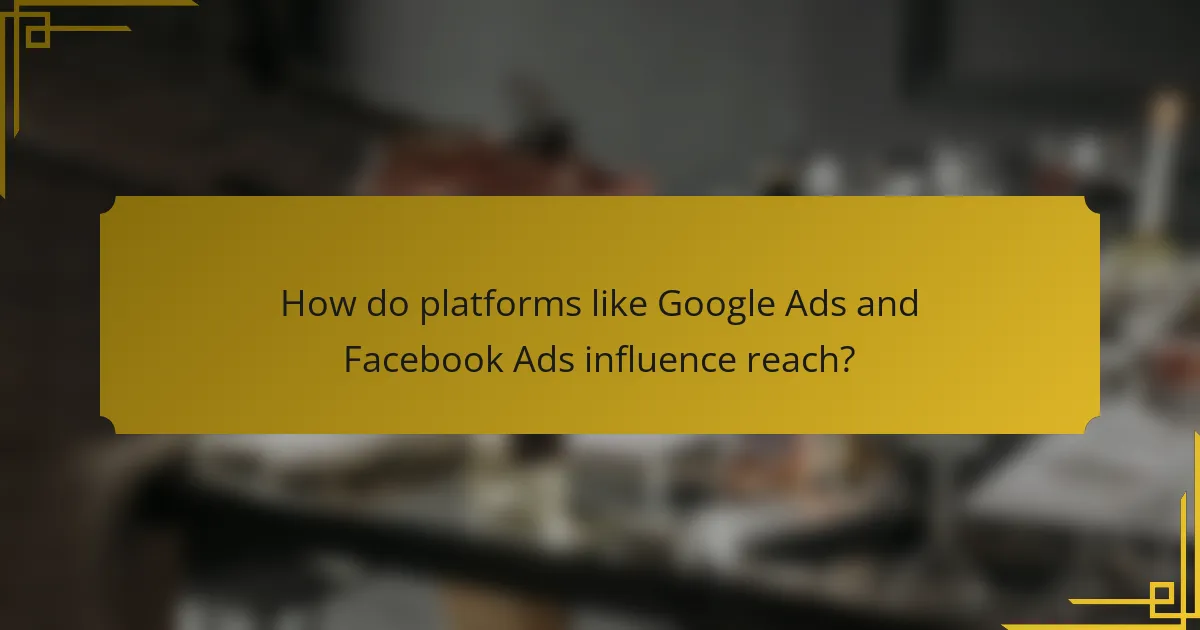
How do platforms like Google Ads and Facebook Ads influence reach?
Google Ads and Facebook Ads significantly enhance reach by targeting specific audiences through paid promotions. These platforms allow businesses to increase visibility and engagement, often leading to higher conversion rates compared to organic methods.
Overview of Google Ads impact
Google Ads operates primarily on a pay-per-click (PPC) model, enabling businesses to bid on keywords relevant to their products or services. This approach ensures that ads appear in search results when users are actively looking for related information, which can lead to immediate traffic and potential sales.
One key consideration is the competition for keywords; high-demand terms can be costly, often requiring budgets in the hundreds to thousands of USD monthly. However, effective targeting and ad optimization can yield a strong return on investment (ROI).
Overview of Facebook Ads impact
Facebook Ads leverage user data to create highly targeted advertising campaigns based on demographics, interests, and behaviors. This allows businesses to reach potential customers in a more personalized manner, which can enhance engagement and brand loyalty.
Costs for Facebook Ads can vary widely, with average costs per click typically ranging from a few cents to several dollars, depending on the audience and competition. Advertisers should monitor performance metrics to adjust their strategies for optimal results.
Comparative effectiveness of platforms
When comparing Google Ads and Facebook Ads, the effectiveness largely depends on the business goals and target audience. Google Ads excels in capturing demand at the moment of search, making it ideal for direct sales and lead generation.
Conversely, Facebook Ads are more effective for building brand awareness and engaging users through visual content. Businesses often benefit from a combined strategy, utilizing both platforms to maximize reach and impact.
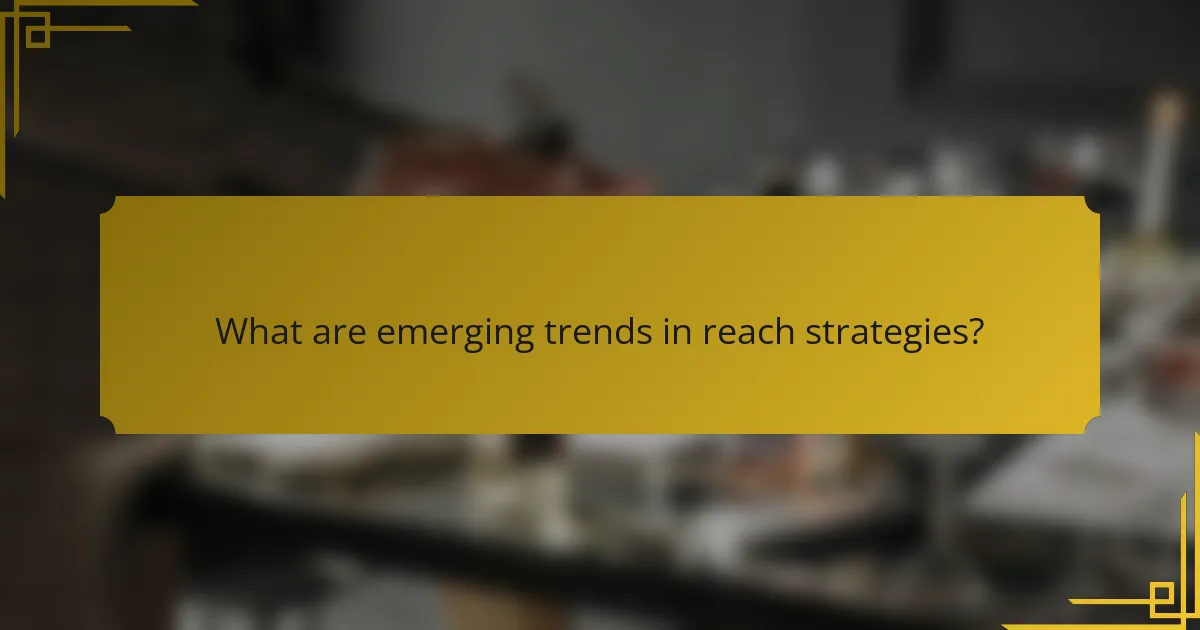
What are emerging trends in reach strategies?
Emerging trends in reach strategies focus on the integration of paid and organic methods to maximize audience engagement. Marketers are increasingly leveraging data analytics and AI to refine targeting and optimize content distribution across platforms.
Increased reliance on data analytics
Data analytics is becoming essential for both paid and organic reach strategies. By analyzing user behavior and engagement metrics, marketers can identify which content resonates most with their audience. This insight allows for more effective targeting in paid campaigns and helps shape organic content strategies.
For example, businesses can use tools like Google Analytics or social media insights to track performance and adjust their strategies accordingly. This data-driven approach can lead to higher conversion rates and improved customer satisfaction.
Integration of AI in content creation
Artificial intelligence is increasingly being used to enhance content creation for reach strategies. AI tools can analyze trends and generate content ideas that align with audience interests, making it easier to produce relevant material quickly. This can be particularly beneficial for organic reach, as timely content often performs better.
Moreover, AI can assist in personalizing marketing messages, ensuring that both paid and organic content speaks directly to the target audience. This personalization can significantly boost engagement rates and brand loyalty.
Focus on multi-channel strategies
Multi-channel strategies are gaining traction as brands seek to engage audiences across various platforms. By combining paid advertising with organic reach efforts, businesses can create a cohesive brand experience that drives higher engagement. This approach allows for greater visibility and reinforces messaging across different touchpoints.
For instance, a company might run a paid campaign on social media while simultaneously optimizing its website for organic search. This dual approach can lead to increased traffic and conversions, as users encounter the brand in multiple contexts.
